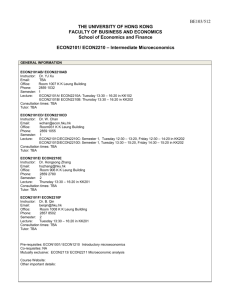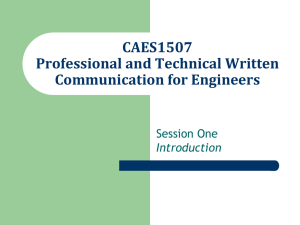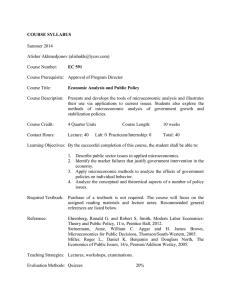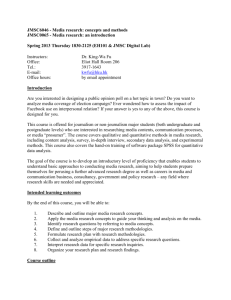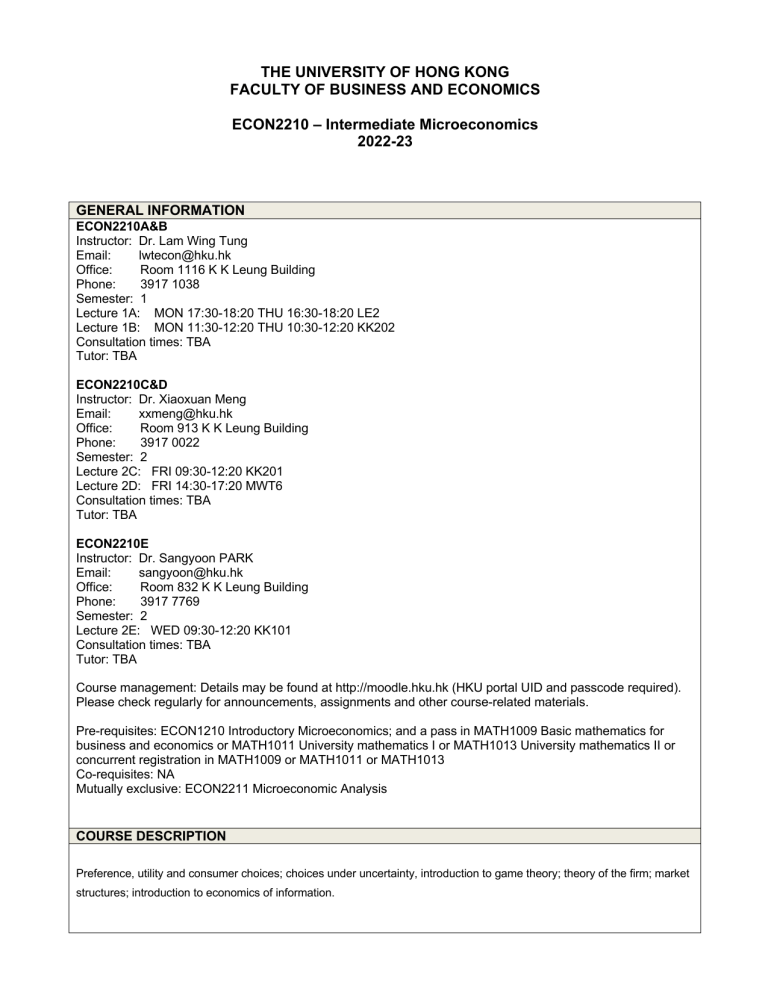
THE UNIVERSITY OF HONG KONG FACULTY OF BUSINESS AND ECONOMICS ECON2210 – Intermediate Microeconomics 2022-23 GENERAL INFORMATION ECON2210A&B Instructor: Dr. Lam Wing Tung Email: lwtecon@hku.hk Office: Room 1116 K K Leung Building Phone: 3917 1038 Semester: 1 Lecture 1A: MON 17:30-18:20 THU 16:30-18:20 LE2 Lecture 1B: MON 11:30-12:20 THU 10:30-12:20 KK202 Consultation times: TBA Tutor: TBA ECON2210C&D Instructor: Dr. Xiaoxuan Meng Email: xxmeng@hku.hk Office: Room 913 K K Leung Building Phone: 3917 0022 Semester: 2 Lecture 2C: FRI 09:30-12:20 KK201 Lecture 2D: FRI 14:30-17:20 MWT6 Consultation times: TBA Tutor: TBA ECON2210E Instructor: Dr. Sangyoon PARK Email: sangyoon@hku.hk Office: Room 832 K K Leung Building Phone: 3917 7769 Semester: 2 Lecture 2E: WED 09:30-12:20 KK101 Consultation times: TBA Tutor: TBA Course management: Details may be found at http://moodle.hku.hk (HKU portal UID and passcode required). Please check regularly for announcements, assignments and other course-related materials. Pre-requisites: ECON1210 Introductory Microeconomics; and a pass in MATH1009 Basic mathematics for business and economics or MATH1011 University mathematics I or MATH1013 University mathematics II or concurrent registration in MATH1009 or MATH1011 or MATH1013 Co-requisites: NA Mutually exclusive: ECON2211 Microeconomic Analysis COURSE DESCRIPTION Preference, utility and consumer choices; choices under uncertainty, introduction to game theory; theory of the firm; market structures; introduction to economics of information. COURSE OBJECTIVES 1. To help students develop a solid background in microeconomic theory 2. To expose students to different fields in microeconomics 3. To acquire the ability to apply microeconomic theory to real world policy issues and problems FACULTY GOALS Goal 1: Acquisition and internalization of knowledge of the programme discipline Goal 2: Application and integration of knowledge Goal 3: Inculcating professionalism Goal 4: Developing global outlook Goal 5: Mastering communication skills Goal 6: Cultivating leadership COURSE LEARNING OUTCOMES Course Learning Outcomes Aligned Faculty Goals CLO1 Apply the basic analytic framework and methods of microeconomic analysis to Goal 1, 2 systematically solve economic problems CLO2 Offer analytic insights on social, economic, and policy issues Goal 1, 2, 4 COURSE TEACHING AND LEARNING ACTIVITIES Expected contact hour Study Load (% of study) T&L1. Lectures 36 hours 30 T&L2. Tutorials 12 hours 10 T&L3. Self study 72 hours 60 120 hours 100% Weight Aligned Course Learning Outcomes A1. Midterms 30 CLO1, CLO2 A2. Final 50 CLO1, CLO2 A3. Problem sets 20 CLO1, CLO2 Course Teaching and Learning Activities Total Assessment Methods Brief Description (Optional) Total 100% STANDARDS FOR ASSESSMENT Course Grade Descriptors A+, A, A- Candidate has consistently demonstrated a thorough grasp of the subject as evidenced by original or exceptionally astute analysis and synthesis. B+, B, B- Candidate frequently demonstrated a substantial grasp of the subject. C+, C, C- Some of the responses are well organized, clear but with insufficient elaboration. D+, D F Solutions to questions and problems containing unstructured but relevant observations, and marginally interesting. Little evidence of basic familiarity with the subject. Assessment Rubrics for Each Assessment (Please provide us the details in a separate file if the space here is not enough) Answers to Midterm and Final examinations are to be graded in accordance with the standards stated above in course grade descriptors. COURSE CONTENT AND TENTATIVE TEACHING SCHEDULE Topics that will be covered can include: 1. 2. 3. 4. 5. 6. 7. 8. 9. Theory of Consumer Choice and the Demand for Goods Theory of the Firm and the Supply of Goods Equilibrium in the Competitive Product Market Monopoly and Monopsony Monopolistic Competition, Oligopoly, Game Theory The Factor Market General Equilibrium and Economic Efficiency Market Failures: Externalities and Public Goods Information and Uncertainty REQUIRED/RECOMMENDED READINGS & ONLINE MATERIALS (e.g. journals, textbooks, website addresses etc.) 1. 2. Pindyck and Rubinfeld, Microeconomics (Ninth Globle Edition). Upper Saddle River, N.J.: Pearson, 2018. Varian, Hal R., Intermediate Microeconomics: A Modern Approach, Seventh Edition, New York, New York: W.W. Norton & Company, Inc., 2005 MEANS/PROCESSES FOR STUDENT FEEDBACK ON COURSE o o o conducting mid-term survey in additional to SETL around the end of the semester Online response via Moodle site Others: ________________________ (please specify) COURSE POLICY (e.g. plagiarism, academic honesty, attendance, etc.) Plagiarism and Misconduct No plagiarism will be tolerated! The University Regulations on academic dishonesty will be strictly enforced! Please check the University Statement on plagiarism on the web: http://www.hku.hk/plagiarism/. Academic dishonesty is behavior in which a deliberately fraudulent misrepresentation is employed in an attempt to gain undeserved intellectual credit, either for oneself or for another. It includes, but is not necessarily limited to, the following types of cases: Plagiarism - The representation of someone else’s ideas as if they are one’s own. Where the arguments, data, designs, etc., of someone else are being used in a paper, report, oral presentation, or similar academic project, this fact must be made explicitly clear by citing the appropriate references. The references must fully indicate the extent to which any parts of the project are not one’s own work. Paraphrasing of someone else’s ideas is still using someone else’s ideas, and must be acknowledged. The representation of work as solely one’s own when in fact it is the result of a joint effort. Where a candidate for a degree or other award uses the work of another person or persons without due acknowledgment: The relevant Board of Examiners may impose a penalty in relation to the seriousness of the offence;The relevant Board of Examiners may report the candidate to the Senate, where there is prima facie evidence of an intention to deceive and where sanctions beyond those in (1) might be invoked. ADDITIONAL COURSE INFORMATION (e.g. e-learning platforms & materials, penalty for late assignments, etc.)
